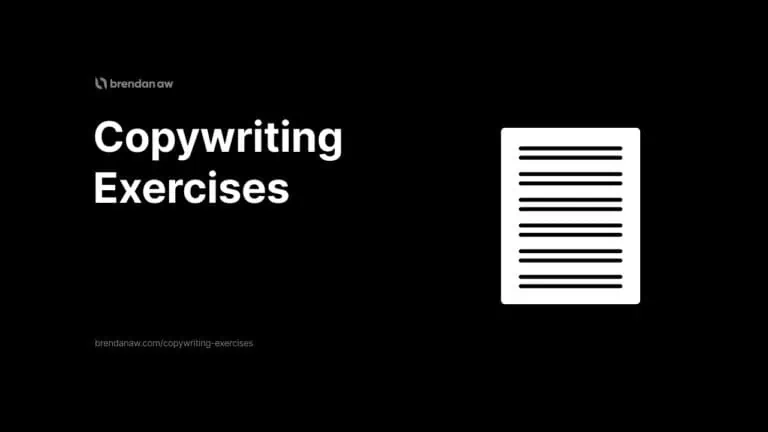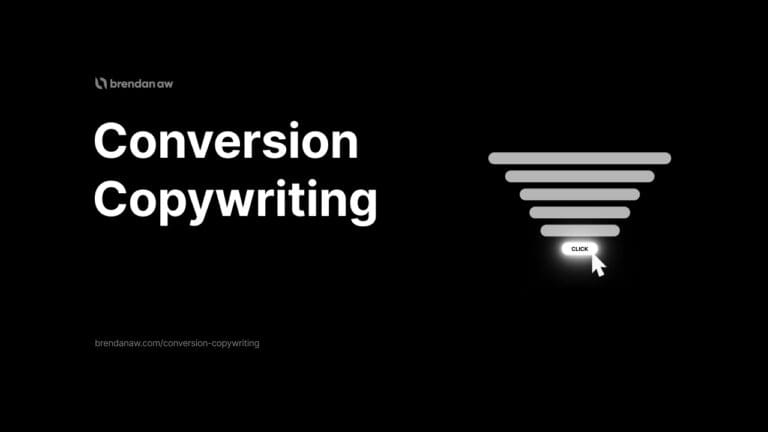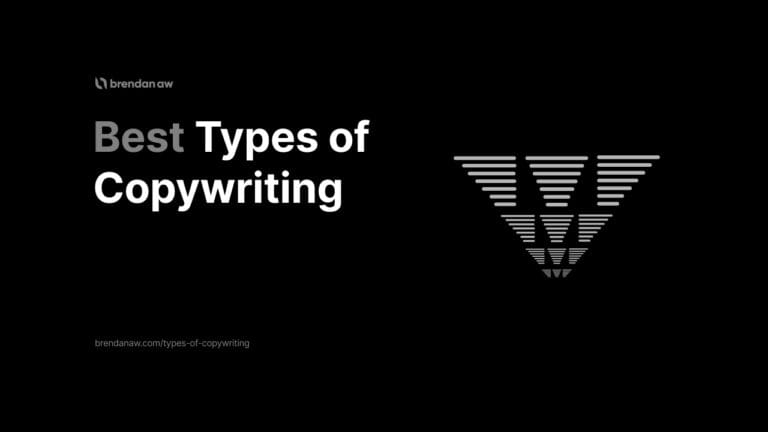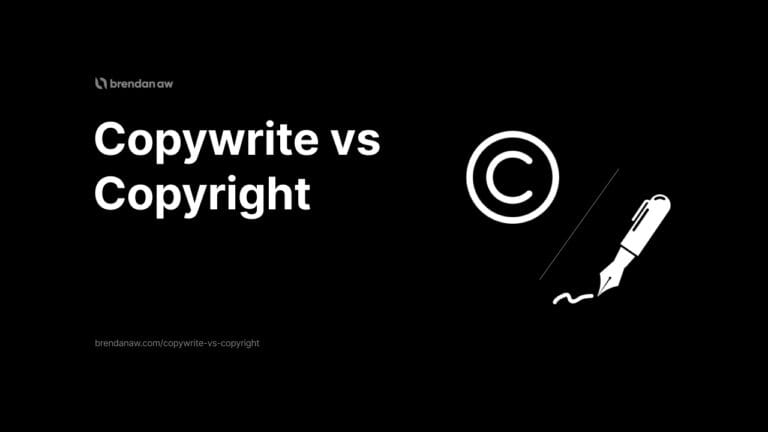Learning how to write copy can be overwhelming…i
But it’s your most important side quest as a creator, as it forms the foundation of all content creation.
If you’re anything like me…
You might not even have known the difference between “copywrite” and “copyright“ initially.
(copywrite isn’t an actual word btw…)
But don’t worry…
I’ll show you how I learned copywriting.
By the end of this post, you’ll discover:
- What most people think about copywriting and what it really is
- The workload and skills needed in this field
- Why is good copy the lifeblood of every business
- Exactly how to become a copywriter
- How to make money from freelance copywriting
Sounds good?
Let’s get started.
What Is a Copywriter?
A copywriter is a professional who writes persuasive text to promote and sell a product, service, or idea.
They are the creative minds behind words that:
- Evoke emotions
- Trigger desires
- Address pain points
Poets write poems.
Songwriters write songs.
Copywriters write copy.
There’s no way you haven’t seen a copy because they are EVERYWHERE.
Whether it’s a catchy advertisement, an engaging blog post, or a persuasive landing page…
You’re reading the work of a copywriter.
A copywriter is a storyteller, a strategist, and a communicator rolled into one.
What Does a Copywriter Do?
Copywriters write copy. Shocker!
It’s easy to assume they just slap words on a blank document…
Wrong.
Anyone can do that.
AI copywriting software might even be better.
The role of a copywriter includes way more strategic tasks like:
- Brainstorming concepts for advertisements and marketing campaigns
- Performing deep market and product research
- Writing persuasive copy for humans that is optimized for SEO
- Conducting A/B testings
- Analyzing campaign results to guide future copywriting strategies
- Proofreading the copy
And if you wanna become a freelance copywriter…
You have to allot time for:
- Learning to be a business owner
- Finding potential clients
- Marketing your services
- Cold pitching
A copywriter’s job goes far beyond writing words.
It’s assembling and refining components into a cohesive message that influences action.
That’s usually a purchase.
Why Is Copywriting Important?
Imagine a world WITHOUT copywriting.
To convey the value of your product or service…
You have to rely solely on:
- One-on-one sales calls
- Face-to-face interactions
- Word of mouth
That’s extremely inefficient.
Not to mention unscalable.
So here are the reasons why copywriting is important to every business:
- Strengthens brand image: It can help position a brand’s value and unique selling proposition (USP) engagingly. Quality copywriting also ensures consistency across marketing materials.
- Increases conversion rates: Effective copywriting convinces readers to act. This leads to increased conversion rates that help scale a business.
- Drives traffic: Well-crafted copy enhances brand visibility and credibility. You do this by integrating relevant keywords and adhering to SEO best practices.
- Communicates with clarity: Strong copywriting conveys your brand’s message clearly and persuasively. So it’s simpler to comprehend your features and their benefits.
- Piques interest: A great hook stops the reader from scrolling. It captivates your audience and holds their interest in your content.
- Scales with the brand: Well-written copy is shareable across various platforms. It allows businesses to expand their influence without investing more time or effort.
What Are the Main Types of Copywriting?
The great thing about copywriting is that it is multifaceted.
There are various types of copywriters. Here are some of their specializations:
- Direct response copywriting (DRC): Any copy that prompts an instant response is an example of direct response copywriting. DRC urges individuals to take action immediately rather than delay.
- Email copywriting: Creates persuasive and compelling content for email marketing campaigns. The goal of every email copy is to guide the readers in their customer journey. Each copy takes a reader one step closer to making a purchase.
- Landing page copywriting: A type of copywriting done for a standalone webpage called a landing page. Every landing page copy is designed to convert visitors into customers.
- Social media copywriting: All about creating copy for social media posts. It is designed to be engaging and shareable. The goal is to increase brand awareness and drive conversions.
- SEO copywriting: Search engine optimization (SEO) copywriting involves crafting content optimized for both readers and search engines. A good SEO copy should rank in search engine results pages and drive traffic to a website.
That’s just the tip of the iceberg.
If you’re curious to learn more copywriting types and find your perfect fit…
You don’t want to miss my article on the best types of copywriting.
What Skills Does a Copywriter Need?
Many assume you need a Journalism or English degree to start working as a copywriter…
Or natural writing talent.
But that’s not the case.
Writing and grammar fluency can help you articulate sentences.
But that alone doesn’t guarantee an effective copy.
And even if you’re not a grammar wizard… AI writing tools can help:
- materialize your ideas
- optimize your content
- proofread your work
Instead… focus on honing the “more important” copywriting skills to become a successful copywriter.
These are:
Conducting Research
Copywriting research is a copywriter’s superpower.
It’ll give you insights into your target audience:
- Demographics
- Preferences
- Needs
- And pain points
Your copy practically writes itself with this information.
Connect your readers’ problems to your solution and voila…
You now have a reader-focused copy to engage your audience.
Researching is also helpful in developing a deep understanding of the product or service.
The more you know about the product…
The better you can articulate its unique selling point…
And the more persuasive your copy will be.
Analyzing Data
Data doesn’t mean a thing when you can’t interpret it.
Copywriters need the following to craft content that resonates and persuades:
- Interpret market trends
- Audience behavior
- Industry statistics
- And more.
Masterful analytical skills will allow you to make informed decisions and fine-tune your strategies.
This proficiency empowers you to write copy that consistently resonates well.
Adapting Different Styles
Copywriters are chameleons of communication.
Be versatile.
Just because copywriting is a one-to-many medium doesn’t mean a copy should appeal to every customer.
Especially if you’re targeting a specific customer type.
You must vary your tone and message for loyal customers and newcomers to your brand.
Adapt to the current sophistication level of the reader.
Marketing trends are rapidly changing.
Algorithms are constantly evolving.
Customer behavior is increasingly unpredictable and diverse.
Either you adapt to thrive or be one-dimensional and be left behind.
If you can’t switch your style in a split second… good luck.
But here’s the beauty of it all.
It sounds difficult…
But not impossible.
You’ve got the potential to master this craft and be the voice that
- Connects
- Persuades
- Sells
Let me teach you the foundations.
How To Start Copywriting?
I know copywriting can be hard…
But it’s not rocket science.
Here are five steps to start copywriting:
1. Immerse Yourself in Various Copy
Many copywriter-wannabes dive headfirst into copywriting books and theories.
While understanding the principles behind each copy is important…
Starting with theory alone might not be the best approach.
Why?
Because copywriting is a skill.
And the best way to enhance a skill is through practical application.
As a beginner… you don’t have writing experience YET.
But you have access to a gazillion real-world applications of copywriting.
So utilize your resources and immerse yourself in diverse forms of copy such as:
- Billboards
- Instagram or Facebook ads
- Magazine and newspaper headlines
- Sales emails
- Business landing pages
The best part?
It’s all FREE.
Before you dive deep into theory…
Observe real-world examples that around you.
And you’ll notice patterns.
They will be your initial push to propel you on your copywriting journey.
This will help you grasp timeless copywriting frameworks and sync with trends.
Here are a few old-school copywriters to look for:
- David Ogilvy
- Eugene Schwartz
- Gary Halbert
- Joseph Sugarman
- Claude Hopkins
And here are some modern-day peeps to follow:
Follow these people to craft influential and relevant copy for today’s rapid digital realm.
2. Write From Day One
Now you have read some real-world copy… time to WRITE one.
“But Brendan… isn’t it too soon?”
Absolutely not. It’s never too soon.
Start writing immediately.
Don’t worry… you’re not expected to write a full-fledged sales page.
Not at this point.
Remember the diverse copy you’ve come across?
Imitate them.
Here are some copywriting exercises to replicate those pieces.
Rephrase Existing Copy
Take a piece of the existing copy and rephrase it in your own words while retaining the core message and persuasive elements.
Focus on capturing the original intent while adding your unique voice.
Create Mock Campaigns
Choose a successful piece of copy and break it down into its key components:
- Headline
- Subheadings
- Body copy
- Call to action
Then use these components to create your piece with a similar structure for a different product.
Handwrite Copy
Select a successful piece of copy from a famous copywriter and rewrite it by hand.
This physical engagement can help you internalize the word choice, structure, and flow of effective copywriting.
Don’t limit yourself to imitating a single piece of copy.
Take inspiration from various sources and combine elements that resonate with you.
Blending different strategies will help you develop a unique and versatile writing style.
3. Learn Copywriting Theories
You have seen real-life copywriting.
You wrote a couple of pieces.
You might have encountered head-scratching moments.
- “Why did that headline grab my attention?”
- “How can I shorten this copy?”
- “What made me keep reading that blog post?”
These inquiries signal the perfect time to dive into copywriting theories:
Human psychology, marketing, and sales.
Human Psychology
Understanding human psychology allows you to connect with and persuade your audience effectively.
“Seriously… Brendan? I want to become a copywriter… not a freakin’ psychologist.”
You don’t need a psychology degree to be an effective copywriter.
But you must understand specific psychological principles that relate to copywriting.
Here are a few examples:
- Social proof: People are more likely to take action if they see others doing the same. Sprinkle in social proof (e.g. testimonials and user reviews) to amp up your copy’s persuasive power.
- Reciprocity: People are more inclined to give back when they receive something first. Hook your audience by offering value upfront.
- Scarcity: Human motivation kicks into gear when something seems rare or in short supply. Highlighting scarcity (e.g. limited-time offers or limited stock) can increase the urgency and persuasiveness of your copy.
- Cognitive fluency: People lean toward easy-to-grasp information. Use simple language, clear formatting and avoid jargon to make your copy more persuasive.
- “You are free” effect: Action blooms when individuals perceive choice. Include phrases such as “you are free to choose” to increase the persuasiveness of your copy.
Here are a few books to dive deeper into human psychology and persuasion.
- Influence: The Psychology of Persuasion by Robert Cialdini: Explores the principles of behavioral psychology that influence people’s decision-making.
- Thinking, Fast and Slow by Daniel Kahneman: Delves into the intricate interplay of two thinking systems that shape our thought processes and decision-making.
- How to Win Friends and Influence People by Dale Carnegie: Provides practical advice on how to improve interpersonal relationships and become more successful in both personal and professional life.
Marketing and Sales
Marketing and sales are the bread and butter of copywriting.
Every copy is geared toward one goal…
Generating sales.
Here are some copywriting books you can explore to learn marketing and sales:
- The Adweek Copywriting Handbook by Joseph Sugarman: Offers insights and techniques for crafting persuasive copy that resonates with audiences.
- The Ultimate Sales Machine by Chet Holmes: Presents a comprehensive guide to increasing sales and productivity. Gives a combination of time-tested principles and innovative approaches.
- Contagious: How to Build Word of Mouth in the Digital Age by Jonah Berger: Explores the psychology behind why certain ideas and products become viral sensations. Provides actionable insights for creating contagious content and fostering word-of-mouth marketing in the modern digital landscape.
4. Learn How To Research Your Market
When you can articulate the problem of your reader better than they can…
They will instinctively ask you for your solution.
Copywriting is all about understanding your target audience.
And the only way you would know your audience from front to back… is through research.
Understand their needs, desires, and pain points…
Then tailor your copy to resonate, solve, and convince.
That’s how you essentially “read their minds” and make them go…
“Damn… how did you know?”
What should you look for during market research?
There are essentially four buckets of information…
- Desires/Wants/Goals
- Problems/Needs
- Frustrations
- Fears
What are Anecdotes?
These are stories people share about a product.
It’s your target audience telling you what problems they are facing.
You can find them in places like:
- Social media
- Product reviews
- Forums
- Competitors’ blogs
- Google People Also Ask (PAA)
Gather all the information from these sources and sort them into the five buckets.
These give you everything you need to write effective copy.
5. Get Feedback and Improve
After learning some theory… you can probably spot your weak points and rectify them.
But here’s the thing…
There are nuances that only seasoned copywriters can decipher.
So if you want to accelerate your progress…
Observe some bad copywriting examples and seek feedback from experienced individuals.
Join communities and surround yourself with other copywriters.
Specifically… those that are more experienced than you.
- Ask questions
- Give feedback
- Contribute value
Remember the reciprocity principle?
People are more likely to help if you give value upfront.
I find X (formerly Twitter) and LinkedIn the best platforms for this.
How To Become a Freelance Copywriter?
Starting as a freelance copywriter can equip you with the skills you’ll need when you decide to start your own creator business.
Here’s a step-by-step guide on how YOU could become a freelance writer as a beginner.
1. Identify Your Niche
Wanna make a living being a freelance copywriter?
Pick a freakin’ niche.
Here’s why:
- A niche can make your marketing efforts easier and more effective.
- It positions you as an expert in a specific industry or type of copy. This is critical to landing high-paying clients.
- Choosing a niche allows you to collect hyper-relevant samples to send to potential clients.
- It will help you stand out from other copywriters.
- Generalists don’t make as much money as they used to.
But I know choosing a niche can be challenging.
Especially if you have zero experience in copywriting.
So before I give you a step-by-step guide to pick your niche…
You have to know what makes a good niche.
What Makes a Good Copywriting Niche?
A good copywriting niche should tick as many boxes in the following criteria:
- Profitability: A copywriting niche should be profitable and have a high demand.
- Interest: You must have a genuine interest in the niche you choose. This will make it easier to stay motivated and produce high-quality work.
- Expertise: You must have some level of expertise in your chosen niche. This will allow you to sound more authoritative and use the appropriate jargon in your copy.
- Competition: Competition is a sign of a thriving industry. But choose a niche with a manageable level of competition. Too much competition can make it difficult to stand out and find clients.
- Potential for growth: A good copywriting niche must have the potential for growth and expansion. This will allow you to continue to develop your skills and increase your earning potential over time.
How To Choose a Copywriting Niche?
Here are 3 considerations to guide you in choosing your copywriting niche:
- Personal assessment: Reflect on your current skills, life experience, and interests. This will give you a good idea of what industries or niches you may be interested in pursuing.
- Research: Create a list of potential niches. Then research each one to determine its profitability, demand, and competition. Look for growing industries with a high demand for copywriting services.
- Experiment: Pick one and give it a shot. Stick to it long enough to see which ones you enjoy the most and where you excel.
Here are more copywriting niches to give you ideas.
2. Conduct Market Research
Congrats on choosing a niche!
You’re now ahead of countless jack-of-all-trades copywriters.
Let’s snowball that advantage through market research.
Here are the key information to look for when conducting your research:
- Target demographics: Age, gender, income, and education level.
- Psychographics: Values, beliefs, interests, and lifestyles.
- Competitor analysis: Their strengths, weaknesses, and unique selling points.
- Industry trends: Emerging technologies, new products, and changing consumer behavior.
3. Write Spec Pieces
Tell me if this is familiar…
You can’t write a copy because you don’t have a client.
But you can’t land a client because you have no copy to show.
Break that vicious cycle by writing spec pieces.
“What the heck are spec pieces?”
Copywriting spec pieces are writing samples for imaginary products or services.
Write a copy for an imaginary brand in your chosen niche. (e.g., email sequence, social media ad, landing page, etc.)
Creating these pieces helps you showcase your skills to potential clients as a brand-new copywriter.
That raises a question…
How can you showcase your work to your potential clients?
4. Create a Copywriting Portfolio
Build your copywriting portfolio once you have 3-5 samples.
Present your work via Google Drive or a personal portfolio website.
“Which is better?”
I recommend setting up a dedicated website because of today’s competitive copywriting landscape.
A personal website will make you look professional and stand out from the competition.
You can still use Google Drive, though…
Also… NEVER forget to update the “Shared access” link.
A “You don’t have access to this file” screen is a huge turn-off.
Goodbye opportunities.
5. Outreach to Potential Copywriting Clients
“Build your own brand and clients will come…”
It might sound enticing…
But it’s not a guaranteed path to landing clients.
If you want to get clients FAST… you can’t be passive.
You have to go to them.
Perform outreach.
You know the market research you did earlier?
You probably know the struggles they’re facing.
And the platforms that serve as hotspots for finding copywriting clients.
These platforms are where most people hire copywriters.
So make yourself known.
But be careful…
Don’t slide into DMs saying, “Hey… I’m a freelancer. I’m hardworking. I’m good. Hire me!”
Your message will either end up in the spam folder or get deleted.
Trust me… that happens all the time when I’m hiring writers.
So rather than a direct pitch…
Start by offering value.
Share insights, provide solutions, or initiate discussions that resonate with your target audience.
This value-first approach positions you as a resourceful professional rather than a pushy salesperson.
Alternatively…
You can go the traditional route and create profiles on job boards like:
- Upwork
- Fiverr
- Freelancer.com
- SolidGigs
I never found that much success on these platforms but you might.
How Much Can a Copywriter Make?
My blog isn’t about teaching you to get a copywriting job.
But if you want to start a copywriting career as a stepping stone to launching your creator business…
Here are some salary figures.
The average annual salary of copywriters in the United States with 0 to 1 year of experience is $53,326.
That’s around $4,444 per month.
The average annual salary is $59,754. That’s equivalent to around $4,980 per month.
Keep in mind that these figures are averages.
These wages vary due to factors like cost of living.
Here’s a breakdown of the highest-paying cities in America for copywriters:
| City, State | Average annual pay | Average monthly pay |
| San Francisco, CA | $88,039 | $7,337 |
| San Diego, CA | $77,956 | $6,496 |
| Charlotte, NC | $ 77,273 | $6,439 |
| New York, NY | $73,783 | $6,149 |
| Seattle, WA | $67,717 | $5,643 |
| Salt Lake City, UT | $66,126 | $5,511 |
| Austin, TX | $62,596 | $5,216 |
| Orlando, FL | $58,080 | $4,840 |
| Scottsdale, AZ | $52,665 | $4,389 |
It’s trickier to compare the yearly income of freelance copywriters.
There’s a huge variance between the full-time copywriters and others who treat copywriting as a side hustle.
Here’s a rough estimate of ZipRecruiter for freelancers’ salaries as of 8th August 2023.
The average hourly pay in the United States is $44.87 an hour.
That’s around $86,150 annually if the copywriter works 40 hours per week.
But here’s the kicker…
X (Formerly Twitter) is a gold mine for copywriters.
Don’t believe me?
Here’s a glimpse into the earnings of an X creator copywriter.
And the best part?
You don’t need a massive follower count to rake it in.
I know these numbers may seem outrageous.
But don’t get me wrong…
I can’t guarantee you’ll be rolling in this kind of cash.
These figures are just to show you the potential and serve as motivation.
The same goes for LinkedIn.
How To Become a Copywriter (FAQs)
What Is the Difference Between Copywriting and Content Writing?
Copywriting focuses on persuading and selling, while content writing educates and entertains.
How Do I Set My Copywriting Rates?
Many beginners start by searching “average rates of a copywriter” and then proceed to charge the figures they see. This can be a viable option when you’re starting out.
But copywriting has a huge impact on a business’s success.
Therefore, it’s reasonable to get compensated based on how much money your copy generates.
I recommend you consider charging on a commission-based or retainer-based model.
Other popular options can include an hourly rate or a project-based fee.
What Tools Can Aid My Copywriting Process?
The good thing about being a copywriter is that you don’t need to be tech-savvy to earn money online.
You only need text editing software like Google Docs or Microsoft Word. But if you wanna elevate your copywriting skills… consider trying AI copywriting software like Jasper AI.
I also use Grammarly and the Hemingway App to assess the readability of my content.
What’s the Role of Storytelling in Copywriting?
Storytelling is the origin of copywriting.
Incorporating stories into your copy will “humanize” your message. It makes your copy relatable and memorable.
The internet is filled with soulless AI-generated content online.
So I believe it’s just a matter of time before people actively seek out ‘human’ writers with whom they can connect.
Stories from real human experiences are a powerful tool to bridge those connections.
What Are the Essential Soft Skills for a Successful Copywriter?
Besides being a word wizard, you’ll need to be a…
• great communicator
• curious researcher
• and master of time management
Also…
Copywriting is a DYNAMIC endeavor.
Get ready to switch between different brand voices and work with various teams.
How Can I Stay Updated With The Latest Copywriting Trends and Techniques?
Stay ahead of the game by…
• Keeping up with industry blogs (like mine)
• Hanging out on X and LinkedIn
• Joining online forums
• taking copywriting courses
How Important Is It for a Copywriter To Understand SEO?
You don’t have to be an expert…
But knowing the basics of SEO will help you create content that ranks well on search engines and brings in organic traffic.
This skill is highly sought after by clients.
It will also help you secure the top positions on Google search engine results pages (SERPs) for your own website.
More traffic equals more money.
Is It Necessary To Have a Formal Education in Copywriting?
No. You absolutely don’t need a formal education to be successful in copywriting.
Don’t listen to the nonsense other sites tell you.
Spending thousands going through a 3 to 4-year course?
You don’t need that.
Most successful copywriters either have an unrelated degree or don’t have one at all.
You can find all the information you need online either for free or way cheaper than going to school.
How Long Does It Take To Become a Copywriter
I can’t give you a set duration.
It’s obviously going to take longer if you are starting with no experience.
But expect to spend a few months of daily practice before you become proficient at copywriting.
To Sum Up
That was a lot of info, wasn’t it?
Let’s quickly recap the key points covered in this article:
- A copywriter’s role involves crafting persuasive content to prompt action.
- Copywriting is more than just writing copy.
Other tasks include:
- conducting market and product research
- performing A/B testing
- analyzing campaign outcomes
I also shared a detailed step-by-step guide on copywriting…
And insights on how to start a freelance copywriting career.
If this wasn’t enough…
Here are even more copywriting tips for you.
But remember…
Reading these guides won’t take you far… unless you put them into action.
So start taking proactive steps and apply these tips to see real progress.
You are just getting started.










